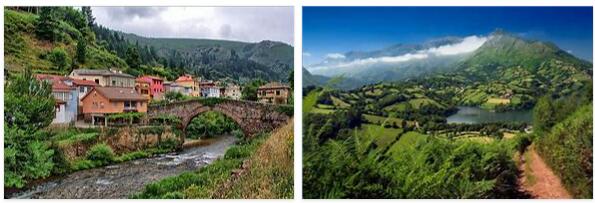Asturias (Spain)
Asturias is a principality and an autonomous community Spain. It is located in the northwestern part of the country and is identical to the location and area of the province of Asturias. Its capital is Oviedo, where 212,000 people live.
Landscape and geology of Asturias The area of Asturias is located
between the Cantabrian Sea in the north and the Cantabrian Mountains in the south. The neighbors are Galicia, Castile-León andCantabria. The coastal region of Costa Verde is particularly popular. Here there are wonderful sandy beaches, some of the most beautiful beaches Spain count. The climate here is also shaped by the ocean, which means that the hot and dry climate of southern Spain does not prevail here, but rather mild temperatures and pleasant humidity. Compared to other climatic regions in Spain, you will also find considerably more green spaces here.
The history of Asturias
Archaeologists discovered Stone Age cave paintings in the Asturian area. These animal drawings are an estimated 15,000 years old. Over 700 dolmens were also found in the region. Many of them are very well preserved because they were buried.
It is believed that the first settlements were made by the Iberians originated and were inhabited. People realized early on that the soil was rich in treasures such as gold. Settlements were established so that these could be excavated. Different generations lived here for over 1,000 years. Today one gradually discovers these buried settlements and exposes them again.
The Castro de Coana dates from around 800 BC. When the Celts settled in the Asturian region and lived here as shepherds.
Like many other regions, this area was also founded around 25-19 BC. Chr. Part of the Roman Empire. However, the Asturians did not want to surrender to this fate, they were a rebellious people. It is therefore assumed that this constant rebellion could be a reason for the relatively late incorporation into the Roman regime.
After the Roman rule ended in the 5th century, the Visigoths followed. When the Muslims wanted to conquer the peninsula from 711 to 719, the resistance of the Christians came from Asturias. The Goth Pelayo is said to have been the leader of the resistance. His followers made him their king. Pelayo is said to have even set up a force in 722, which was used in the battle of Covadonga a force of the Muslim governor of Asturias is said to have defeated. Today this victory is called the beginning of the Reconquista.
Asturias, together with the Basque Country, represented an important focus in the industrialization of Spain in the 19th century. Mining and heavy industry in particular were located in the region and developed quickly.
The mining revolution also started in Asturias. The legendary October Revolution took place here in 1934. The army of the government at the time put down the uprising by force.
During the Spanish Civil War the republican resistance was concentrated in the Asturian region. In the summer of 1937, Asturias fell to Franco’s troops despite resistance.
Since January 11, 1982, Asturias is again an Autonomous Community of Spain.
Business and industry
The mining industry has, because of the large deposits of natural resources affected, Asturias. Since this branch has tended to decline, economic progress is now also concentrated on other sectors. The entire region has been subject to structural change since 1970. But so far the economic growth rate is far behind compared to the other Spanish regions.
The second important sector in Asturias is that Agriculture. Due to the favorable climate, there is plenty of cultivation here. The yields are very good here.
Also the tourism has expanded in recent years and discovered as a way to economic recovery. For the time being, domestic tourism is still taking place, but Asturias should also become more attractive internationally.
Asturias Geography
Asturias is an autonomous community in the Kingdom of Spain. The former Principality of Asturias is located in the northwest of Spain and borders Galicia in the west, Castile-León in the south, Cantabria in the east and the Cantabrian Sea in the north forms the natural border of the country.
The total area of Asturias is about 10,600 square kilometers. The capital of the region is Oviedo. Asturias stretches along the Bay of Biscay and the coast known as “Costa Verde” is home to some of the most beautiful beaches in Spain. The Cantabrian Mountains shapes the landscape of Asturias to a large extent. On the southern border with Cantabria, the mountain ranges of the Picos de Europa even swing up to alpine heights. Rugged mountains and high passes form the border to Cantabria, and Asturias is only connected to the interior of Spain via the 1,379 meter high Pajares Pass. The mountains also act as a climatic divide and separate Asturias from the dry Meseda of the central Spanish plateau.
The Oviedo basin in the middle of Asturias is practically the green heart of the region, in its fertile and slightly hilly landscape intensive agriculture is practiced. The country’s coast is characterized by deep gullies, numerous bays and rugged cliffs. In the west, Asturias, like its neighbor Galicia, is extremely green and is mainly used as meadows and pastureland. In addition to high-yield agriculture, the hard coal, zinc and iron ore deposits in Asturias play a rather insignificant economic role. The majority of the population can be found in the fertile valleys of the center of the country, while the mountain regions are very sparsely populated.
